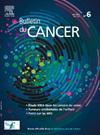Primary cutaneous/subcutaneous Ewings sarcoma
IF 0.8
4区 医学
Q4 ONCOLOGY
引用次数: 0
Abstract
Amongst Ewing sarcoma family of tumours, (EFST), cutaneous/subcutaneous Ewing sarcoma are defined as tumours arising from cutaneous or subcutaneous tissue, not invading the underlying aponeurosis. They are rare tumours, with less than 200 patients published. They are typically small tumours (less than 5 cm), and can arise at any anatomical location, with a particular tropism for distal, truncal and head/neck locations, compared to classical Ewing sarcoma. Like other conjunctive tumours, they have to be treated in specialized centers, with a diagnostic procedure following ESMO guidelines about soft-tissue tumours, favoring a core needle biopsy in most cases. They share classical pathological and molecular features of EFST (including EWSR1 rearrangement). Metastatic presentation is rare (less than 5% at diagnosis), but must be carefully searched using appropriated imaging considered the bad prognosis of these patients. Treatment strategy relies on neoadjuvant and adjuvant chemotherapy, surrounding the local treatment. Patients with localized disease have good prognosis and have to be treated with the dual objective of curability, and of minimizing acute and late toxicity. That is why in case of small tumours (<200 mL), patients can be treated with less intensive protocols, as Saint Jude's (low-dose semi-continuous cyclophosphamide/doxorubicin regimen as induction chemotherapy and vincristine/actinomycin courses as maintenance therapy), setting aside the option of classical VDC/IE protocol for larger tumors. Local treatment must rely on carcinologic surgery, with the aim to avoid radiotherapy when possible. Patients with metastatic disease have bad prognosis resemble classical Ewing sarcoma, and have to be treated accordingly.
Les tumeurs d’Ewing cutanés/sous-cutanés sont des tumeurs rares (moins de 200 patients publiés) appartiennent aux tumeurs de la famille Ewing (TE), avec lesquelles elles partagent leurs caractéristiques anatomopathologiques et moléculaires (réarrangement du gène EWSR1). Elles sont définies par leur développement dans les tissus cutanés/sous-cutanés, sans invasion de l’aponévrose sous-jacente. Ce sont typiquement des tumeurs de petite taille, de localisations ubiquitaires, avec un tropisme particulier pour les sites distaux des membres, tronculaires et ORL. Leur prise en charge, comme celles des tumeurs conjonctives malignes, doit se faire en centre spécialisé. Les métastases sont rares au diagnostic (<5 %), mais doivent être recherchées par un bilan d’extension adapté (TEP TDM/TDM thoracique). Leur traitement repose sur un traitement local (basé sur une chirurgie carcinologique), encadrée par une chimiothérapie néoadjuvante et adjuvante. Les patients porteurs d’une maladie localisée ont un excellent pronostic, (en comparaison aux tumeurs d’Ewing classiques) et doivent être traités avec le double objectif de curabilité, et de réduction des toxicités post-thérapeutiques. C’est pourquoi, en cas de tumeurs de petit volume (<200 mL), on propose l’utilisation des protocoles moins intensifs, comme le protocole Saint Jude (schéma semi-continu de cyclophosphamide faible dose et doxorubicine en induction et vincristine/actinomycine en traitement d’entretien), réservant l’option du schéma classique VDC/IE pour les tumeurs plus volumineuses. Le recours à la radiothérapie externe doit être évité lorsque cela est possible. Les patients atteints d’une maladie métastatique ont un mauvais pronostic, comme les tumeurs d’Ewing classiques et doivent être traités en conséquence.
原发性皮肤/皮下尤文氏肉瘤。
在尤因肉瘤家族(EFST)中,皮肤/皮下尤因肉瘤被定义为起源于皮肤或皮下组织的肿瘤,不侵犯潜在的腱膜。它们是罕见的肿瘤,发表的病例不到200例。与经典的尤文氏肉瘤相比,尤文氏肉瘤通常是小肿瘤(小于5cm),可以发生在任何解剖位置,尤其倾向于远端、躯干和头颈部。像其他结膜肿瘤一样,它们必须在专门的中心进行治疗,其诊断程序遵循ESMO关于软组织肿瘤的指南,在大多数情况下倾向于核心针活检。它们具有EFST的典型病理和分子特征(包括EWSR1重排)。转移表现罕见(诊断时小于5%),但考虑到这些患者预后不良,必须使用适当的影像学仔细检查。治疗策略依赖于新辅助和辅助化疗,围绕局部治疗。局部疾病的患者预后良好,必须以治愈和减少急性和晚期毒性为双重目标进行治疗。这就是为什么在小肿瘤(
本文章由计算机程序翻译,如有差异,请以英文原文为准。
求助全文
约1分钟内获得全文
求助全文
来源期刊

Bulletin Du Cancer
医学-肿瘤学
CiteScore
1.90
自引率
16.70%
发文量
224
审稿时长
37 days
期刊介绍:
Without doubt, the ''Bulletin du Cancer'' is the French language publication of reference in the field of cancerology. Official organ of the French Society of Cancer, this journal covers all the information available, whether in the form of original articles or review articles, but also clinical cases and letters to the editor, including various disciplines as onco-hematology, solids tumors, medical oncology, pharmacology, epidemiology, biology as well as fundamental research in cancerology. The journal proposes a clinical and therapeutic approach of high scientific standard and regular updates in knowledge are thus made possible. Articles can be submitted in French or English.
 求助内容:
求助内容: 应助结果提醒方式:
应助结果提醒方式:


